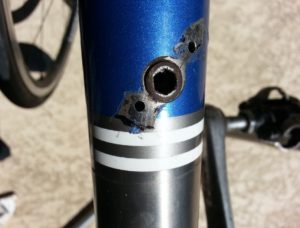It’s been a while since I posted. I’ve been working on this compendium of annoying bicycle noises for over a month. The list keeps growing faster than I can write, so I’m gonna publish this “part one” and keep working on the rest.
Don’t you hate it when your bike is making a clicking, or creaking, or ticking, or buzzing noise and you can’t figure out what it is? I do! It’s especially annoying on carbon fiber bikes and wheels because they seem to amplify noises and echo them all over the bike. I’ve heard a lot of noises, and I’ve been able to run most of them down. I’ve also heard about some weird ones from friends who have been able to eliminate them.
One of the keys to finding the noise is the rhythm. Does it repeat in time with your pedal stroke, with wheel rotation, or with bumps in the road? Not that repeating in time with your pedal stroke means it is in the drive train. But it’s a clue. Potential noise sources all over your bike are stressed in time with your pedal stroke, from the handlebars to the quick release skewers.
First, let’s assume that your derailleurs are correctly adjusted and your chain is oiled. Now, in no particular order:
Cracked Frame
I’ve seen two cracked frames that were not the result of crash damage. One, belonging to my friend Pierre was a titanium frame with cracks that propagated from one of the water bottle bolt holes. A creaking noise led to discovery of the cracks. Being an engineer, of course Pierre drilled stress relief holes at the ends of the cracks.
The other was a carbon frame with a crack somewhere down around the bottom bracket. When my friend Ironman stood up to sprint, you could hear the creaking a mile away.
My friend Maverick had a chainstay come unglued from the dropout, but that one was pretty easy to diagnose. The rubber on paint sound, accompanied by a strong braking sensation, was caused by the wheel shifting to the right and rubbing through the chainstay.
Cranks and Crank Arms
Cranks work loose frequently, especially on tapered spline designs. My friend Six-0 turned around and went home from a ride to tighten his fixing bolt. Good thing too, because left loose, the aluminum to steel interface can “round out”, ruining the crankset. Proper torque on the fixing bolt is important. You cannot generate enough torque with a short handled 8mm allen key to properly tighten this bolt. Torques are usually in the 25nm range. Oh, and did you know that you are supposed to re-tighten it after the first few rides.
A loose crank arm is less common on pinchbolt designs like Shimano Hollowtech II, but it can happen. Proper torque (12-14nm) on the 5mm pinch bolts is important. Be careful tightening these. Use a good allen key and be sure to insert it fully into the bolt. It’d be a bad day if you rounded the hex out of a pinch bolt.
I have had two friends with carbon fiber crank-arms where the threaded aluminum insert for the pedal thread worked loose. You could see the pedal spindle wobbling in the socket. That’s a trashed crank arm.
Some cranks, like the Specialized S-Works, are manufactured with a threaded interface between the right arm and the spider. This is really cool for inserting a spider-mounted power meter. But tightening this interface requires a special multi-pin spanner and high torque. It is very difficult to achieve a long-term fix on this design. Plan on visiting your mechanic regularly for a re-tightening. Continue reading “What’s that @#$% Noise!?!?”
